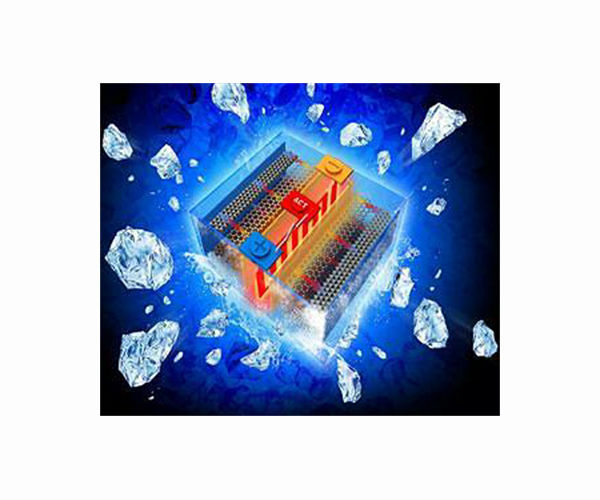‘Cold’ production approach to make batteries of the next generation
Lithium ion batteries have been a staple in the production of devices for years, but the liquid electrolytes on which they trust to function are quite unstable, leading to fire hazard and safety problems. Now researchers from Penn State are aiming for a reliable alternative energy storage solution for use in laptops, telephones and electric vehicles: Solid-State electrolytes (SSEs).
According to Hongtao Sun, assistant professor of industrial and production -engineering, Solid -State batteries -that use SSEs instead of liquid electrolytes -are a leading alternative to traditional lithium ion batteries. He explained that although there are important differences, the batteries work on a fundamental level in the same way.
“Rechargeable batteries contain two internal electrodes: an anode on one side and a cathode on the other,” Sun said. “Electrolytes serve as a bridge between these two electrodes, which quickly offer transport for conductivity. Lithium ion batteries use liquid electrolytes, while batteries of fixed state use.”
Solid-State batteries offer improved stability and safety compared to traditional lithium ion batteries, but are confronted with various production and conductivity challenges, Sun explains. The high temperatures introduced in the manufacturing process, especially with SSEs based on ceramics, can, for example, hinder their production and practical implementation.
To overcome this challenge, Sun and his team used a technique known as cold sintering – a process in which powdered materials are heated, treated with a liquid solvent and compressed in a denser form – to contain a very conducting composite of ceramic polymer that is known as Latppilg. The method is called “cold” because it works at considerably lower processing temperatures than traditional sintering, relying on exerted pressure and a small amount of liquid solvent to complete the process. They published their approach in materials today.
Traditional SSEs based on ceramics are usually composed of polycrystalline granules – materials consisting of hundreds of small crystals – separated by grain boundaries. According to Sun, these grain boundaries are considered defects that impede the transport of conductive ions. To reduce guidance loss in SSEs based on ceramics, Sun’s team has compiled a Poly-ionic gel (Pilg) together with Latp-Keramics to form a polymer-in-ceramic composite SSE, an ideal material for use because of stability and high conductivity.
The PILG acts as a very conductive “grain boundary” in the SSE, which makes ion transport facilitated over developed boundaries rather than through natural interfaces with defects. Sun said that the team initially tried to use traditional sinters at high temperature to develop their new SSEs, but they immediately got into trouble.
“One of the manufacturing challenges of LATP-based composite SSEs is that the sinter temperature for ceramics is very high, to the point that traditional sinter animals would actually burn additives such as the polymer connection before the ceramic could be correctly compacted,” Sun. said. “That’s why we had to implement cold sintering, to keep the temperatures much lower.”
Cold Sintering Technology was originally developed in 2016 via a research project led by Clive Randall, director of Penn State’s Materials Research Institute and Distingughed Professor of Materials Science and Engineering. Its application to the development of fixed Statenbatterijen came in 2018, when a postgraduate scholar has been in the laboratory of Enrique Gomez, professor of chemical engineering and interim-associated dean for equity and inclusion for the College of Engineering, Cold Sintereramic Composite electrolytes.
According to Sun, traditional sintering temperature requires around 80% of the melting point of the material, which can easily reach 900 to 1,000 degrees Celsius for ceramic connections such as LatP.
“For this application we were able to keep our sinter temperatures very low, about 150 degrees Celsius,” Sun said. “This enables us to integrate different types of materials in a very dense form with the help of the cold sinter process, regardless of their different processing temperatures.”
By sintering the Latp ceramics with Pilg gel, SNE’s teams together developed SSEs with high ionic conductivity at room temperature, including strengths.
“In addition to improved conductivity, our polymer-in-ceramic composite SSE showed a very wide voltage window, between 0 to 5.5 volts,” said Sun, in which it was explained that traditional liquid electrolytes have a window of 0 to 4 volts. “The large voltage window of our ceramic SSEs supports the use of high -voltage cathodes, so that the battery can generally generate more energy.”
For the sun, the applications of this cold sintering technology can ever go beyond improving the batteries. He said that he believes that cold Sinter has large implications for how companies approach with the help of ceramic composite materials in general production, as well as in more specific industries such as the production of semiconductors.
“Our next goal is to develop a sustainable production system that supports large -scale production and recyclability, because that will be the key to industrial applications for this technology,” Sun said. “That is the big vision that we hope to work in the coming years.”
Research report:Sonderen of cold sintergregulated interfaces and integration of polymer-in-ceramic fixed states electrolytes

